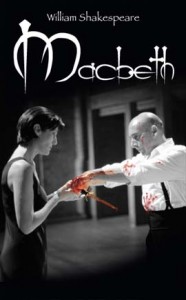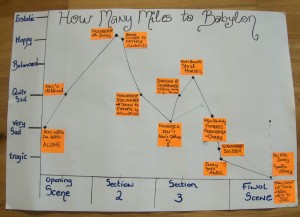Here’s an example of how you can (and must!)
ANSWER THE QUESTION ASKED THROUGHOUT YOUR ANSWER.
Don’t just parrot back the question at the end of each paragraph (although that is still better than ignoring the question completely!) and expect to do well. Everything you say should relate back to the question you were asked. This essay is of very little value to you (except to the extent that it helps you to understand the character of Hamlet a little better) because when the question comes up it won’t be phrased like this. So I am NOT suggesting you memorise this answer – that would be a complete waste of your time and would go against everything I believe in. Instead I want to you look at how everything I discuss relates directly to the question asked. I also want you to see how important it is to have a structure on your essay, so that each paragraph deals with a different idea – this will prevent you from just waffling on and will show the examiner that you are in control and know what you want to say. All of the bold/underlined words are the places where I have either used the exact words from the question or a synonym – but I’m not just parroting back the question, I’m providing supporting evidence and examples from the play to explain why I (mostly) agree with the statement.
“Horror & disgust at his mother’s behaviour & a spreading & deepening of that horror & disgust to include all life dominates Hamlet’s soul”
INTRODUCTION
There is no doubt that Hamlet is horrified and disgusted by his mother’s “o’er hasty” and “incestuous” remarriage to his uncle Claudius. However, it must be acknowledged that Hamlet’s soul is also full of grief for the father he loved so dearly. Furthermore his suicidal disillusionment with life itself is evident from his very first appearance in the play. Once Hamlet discovers that his father was actually murdered by Claudius his horror deepens. His sense that he cannot trust anyone spreads to Rosencrantz & Guildenstern and Ophelia until Hamlet reaches a point where his soul is utterly dominated by a deep disgust for everyone in his life (except Horatio), & for life itself.
Paragraph 1 (a) = MOTHER
At the beginning of the play Hamlet’s deep horror and disgust springs from the fact that his mother’s remarriage came so soon after his father’s death “A beast that wants discourse of reason would have mourned longer”. This seems a betrayal of their life together “frailty thy name is woman” and proof for Hamlet that she must never have truly loved his father. He also sees her new relationship as incestuous “o most wicked speed, to post with such dexterity to incestuous sheets”. His soul is further tortured because he must stay silent despite his disapproval as society demanded absolute obedience to the King & Queen “it is not nor it cannot come to good but break my heart for I must hold my tongue”.
Paragraph 1 (b) = GRIEF & DESPAIR
However, Hamlet’s soul is not dominated purely by horror & disgust – he is also genuinely grieving the death of his father & hero “he was a man, take him for all in all, I shall not look upon his like again”. Hamlet cannot understand why everyone else is so eager to move on “I have that within which passes show; these but the trappings & the suits of woe”. He reveals a suicidal despair in his very first soliloquy, wishing that God had not “fixed his cannon ‘gainst self-slaughter”. This disillusionment with life itself certainly spreads and deepens as the play unfolds.
Paragraph 2 = CLAUDIUS
The appearance of the ghost confirms Hamlet’s earlier suspicions (“I doubt some foul play”) and his dislike of Claudius “a little more than kin and less than kind” transforms into absolute hatred and disgust “o villain, villain, smiling damned villain”. He also begins to suspect his mother of involvement in the crime, evident when he refers to her in scathing terms: “o most pernicious woman”. From this moment on his soul is torn between rage (“haste me to know it that I may…sweep to my revenge”) and despair (“the time is out of joint. O cursed spite that ever I was born to set it right”) as he feels the terrible weight of responsibility to avenge his father’s death battling with his dislike of physical violence and his fear that the ghost is an impostor (“The spirit that I have seen may be a devil… & perhaps… abuses me to damn me”). Thus we see horror, disgust and despair are the dominant emotions in Hamlet’s soul.
Paragraph 3 = ROSENCRANTZ AND GUILDENSTERN
Hamlet’s horror and disgust spreads and deepens to his old school friends Rosencrantz and Guildenstern who appear at court on Claudius’ orders. Hamlet suspects they are spying on him and they admit “My lord, we were sent for”. Hamlet initially trusts them enough to confide “I am but mad north north west” but as the action unfolds he become increasingly frustrated with their interference (“do you think I am easier to be played upon than a pipe?”). Ultimately when Hamlet discovers the letters they carry to England contain orders for his execution, he inserts their names instead so that Rosencrantz and Guildenstern are “put to sudden death no shriving time allowed”. Thus this relationship illustrates how Hamlet’s initial horror and disgust with his mother spreads to other characters. By the end of the play he has such disregard for all life that he sends them to their deaths without a single pang of guilt, proclaiming “they are not near my conscience”.
Paragraph 4 = OPHELIA
Hamlet similarly loses faith in Ophelia when she abruptly breaks off all contact between them (on her father’s orders). He longs to confide in her – “he raised a sigh so piteous and profound as it did seem to shatter all his bulk” but because of his mother’s behaviour he no longer trusts women, remarking “wise men know well enough what monsters you make of them … God hath given you one face and you make yourselves another”. He is horrified and disgusted that she so willingly accepted her father’s insulting assessment of his character (that he was motivated purely by lust not love) and mocks her eagerness to protect her virginity “get thee to a nunnery”. It appears he has lost all respect for women as a result of his mother’s behaviour and Ophelia’s rejection.
Paragraph 5 = HATES SELF & LIFE
Hamlet not only loses faith in those around him, however, he is also filled with a deep self-loathing “o what a rogue and peasant slave am I” and in his most famous soliloquy reveals his desire to die “to be or not to be, that is th question, whether it is nobler in the mind to suffer the slings and arrows of outrageous fortune or to take arms against a sea of troubles and by opposing end them”. Hamlet’s horror and disgust has spread to existence itself but he retains his respect for God and his fear of punishment stops him from killing himself “for in that sleep of death what dreams may come… thus conscience doth make cowards of us all”.
Paragraph 6(a) = STILL LOVES Gertrude & Ophelia
However, Hamlet’s horror and disgust at his mother’s behaviour does not diminish his love for her. He begs her to ask God’s forgiveness so she can save her immortal soul “confess yourself to heaven, repent what’s past, avoid what is to come”. Similarly, although hurt by Ophelia’s ‘betrayal’ he undoubtedly loved her and is deeply upset by the suggestion that he may be partially responsible for her death “I loved Ophelia. Forty thousand brothers could not with all their quantity of love make up my sum”.
Paragraph 6(b) = DISREGARD FOR LIFE – WORKING FOR GOD
Hamlet undoubtedly shows absolute disregard for life when he accidentally murders Polonius (“I’ll lug the guts into the neighbour room”) but he thought he was killing Claudius and now believes he is doing God’s work “for this same lord I do repent but heaven hath pleased it so that I must be their scourge and minister”. In the graveyard scene Hamlet reflects on death as the only certainty in life, the only factor which places a King and a beggar on the same level yet in the final scenes of the play Hamlet’s soul is no longer filled with horror and despair but rather with a belief and acceptance that what will be will be “there’s a divinity that shapes our ends, rough-hew them how we will”. Thus when he finally kills Claudius, Hamlet feels justified in making him drink from the cup he himself filled with poison as Claudius fittingly becomes the victim of his own evil schemes. Hamlet nonetheless retains some respect for the lives of others – he exchanges forgiveness with Laertes & his final deed is to save Horatio’s life “give me the cup, let go” & to give Fortinbras his ‘dying voice’ as the next King of Denmark.
CONCLUSION
In many ways it is almost inevitable that the play depicts a man whose soul is filled with horror and disgust. What human being caught up in this horrific series of events would not react similarly? Let us list for a moment the events he endures: his father’s death, his mother’s hasty & incestuous remarriage, the revelation that the new King – his uncle Claudius – murdered his father, further betrayals by Ophelia and Rosencrantz & Guildenstern, a wasted opportunity to get revenge during the prayer scene, the accidental murder of Polonius followed swiftly by exile to England, Ophelia’s death and funeral; and the plot against him by Claudius & Laertes (which ultimately leaves every major character in the play dead). In these circumstances it is astounding that Hamlet retains any faith at all in God and in divine justice. Yes his soul is filled with horror and disgust but he also ultimately reveals his deep love for Gertrude and Ophelia and profound empathy for Laertes, Horatio and Fortinbras. Thus he deserves the tribute paid to him by Horatio “Now cracks a noble heart. Goodnight sweet prince, and flights of angels sing thee to thy rest” and death seems a blessed release for this tortured soul.







